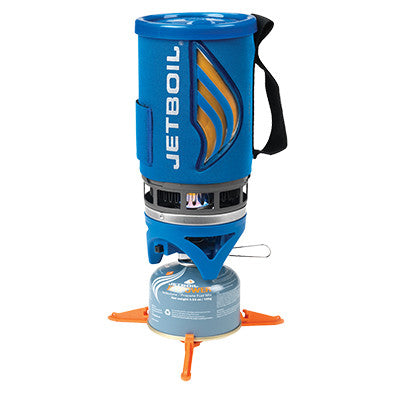Jet Boils Flash

Although some of my family would beg to differ, I’d like to believe I’m a simple man who likes to distil things down to their most basic form. Cut-out the frills and the riff-raff so you can truly function without wasting time and energy. At least that is the way I like to operate in the mountains. I’m there for one purpose and that is enjoying the mountains which to me mainly means climbing. It could be other things to other people – walking, photography, navigating, swimming naked in glacial pools or whatever. Thing is, is that I don’t want to over complicate the other aspects about being in the outdoors: like cooking. I totally respect the people I meet that absolutely froth at the thought of a gourmet wilderness cook-up. Frying, roasting, poaching their way through the food that they dehydrated in their home made dehydrating machine. But I am not one of them; I want tasty food and plenty of it. Now. If you’re similar to me then the Jet Boil cooking system is worth a good look.
Pros
Ease of use
An unstable stove is completely annoying and dangerous. Having a pot sliding around means it has to be watched constantly and being a bit of a cluts, I’d no doubt knock it over. The first thing I appreciated about the Jet Boil is the simple design of the stove and pot clicking together. Not only making it easy to find a stable spot but you can easily walk around carrying it while it’s cooking; but don’t tell Jet Boil or my mum about that. Even in a worst case scenario of knocking it over, with the click on lid and flame relatively protected in the “Flux Ring” then complete catastrophe can at least be avoided.
Efficiency
When comparing the power output of Jet Boils burner compared to other reputable stoves on the market you’ll find that their stove isn’t any hotter. In fact there are plenty of good brands which in fact burn hotter, but that’s not the point. The Jet Boil is all about efficiency. By having a flame that directs to a smaller surface area (not spread) minimal heat is lost. Then there’s the whole ‘Flux Ring’ where the support of the stove integrates with the pot. This insures that enough oxygen can get in without too much heat getting out. When the stove is on full, you can virtually hold your hand against the Flux Ring where the flame is and not get burnt. This is because most of the head is staying inside the Flux Ring where it is needed. Try doing this on a conventional spread flame butane stove with flat based pot and you have blisters for days.
In the real world what I’ve found with all of this is that I use less gas on trips while using the Jet Boil compared to non-integrated stove systems. Gas is weight and the less weight in my bag the more I enjoy myself. It won’t necessarily boil water amazingly quicker than other good stoves in perfect conditions however the gas use is noticeable.
Cons
Can’t fry. The Jet Boil does one thing and does it well: boiling. Don’t expect it to do everything else amazingly. Because of the focused flame if used frying or even simmering things tend to burn easily.
You can only use the integrated pot unless you also purchase the additional pot support
You can get lighter setups. The Flux Ring and pot connection doesn’t come without a slight weight penalty. You can get a lightweight butane stove with small pot that will tip the scales a little lower. What you have to weigh up is if the weight saving of gas is going to make up for the 100 or so grams it might weigh more than an ultra light set up.
Final Result
So if you love coffee, tea and dehydrated meals in the great outdoors than I’d definitely recommend the Jet Boil series of stoves as the best option for general use. It minimises time and fuss associated with cooking and lets you move quickly and lightly. However if you want to get all ‘Nigella Lawson’ on your camp crew then you should probably look to a butane stove that spreads the flame or even better a liquid fuel.

Matt Eaton
Matt likes to keep it simple stupid.
